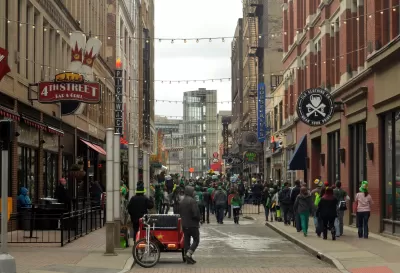In this long-form article, G.M. Donley reminds us why walkable and diverse communities have become such a planning staple. In Cleveland, New Urbanism contends with a history of sprawl and decreasing population.

Though it has marvelous advantages, G.M. Donley observes that modern technology is often guilty of "isolating individuals physically from each other: each commuter traveling in his or her own car, every home a self-contained living and entertainment center, shopping trips carried out from the desktop, social interactions mediated through a little screen."
This can be a serious impediment to diversity: "People are comfortable living among like-minded people, and communication technology and transportation networks make that easier than ever before."
Throughout the article, Donley develops the context to examine how Cleveland—and other "rust belt" cities—might factor into the walkability debate.
- Cleveland has been a historical crossroads, astride key routes of transport but still independent from major centers—and by extension their major developers and inflated real estate prices.
- Walking is what we're meant to do: "humans evolved to walk a lot and our bodies and brains function best when we do that; our past century of not walking a lot has therefore begun to have serious consequences to health and well-being."
- "Efforts are already being made to equip key Cleveland neighborhoods with the fastest fiber-optic and wireless internet capability, to set the stage for future entrepreneurship and innovation. Those initiatives will be most fruitful if conceived around the priority of creating great environments for people on foot."
FULL STORY: Walking and Thinking: Technology and the New Navigation of Everyday Space

Alabama: Trump Terminates Settlements for Black Communities Harmed By Raw Sewage
Trump deemed the landmark civil rights agreement “illegal DEI and environmental justice policy.”

Study: Maui’s Plan to Convert Vacation Rentals to Long-Term Housing Could Cause Nearly $1 Billion Economic Loss
The plan would reduce visitor accommodation by 25% resulting in 1,900 jobs lost.

Why Should We Subsidize Public Transportation?
Many public transit agencies face financial stress due to rising costs, declining fare revenue, and declining subsidies. Transit advocates must provide a strong business case for increasing public transit funding.

Paris Bike Boom Leads to Steep Drop in Air Pollution
The French city’s air quality has improved dramatically in the past 20 years, coinciding with a growth in cycling.

Why Housing Costs More to Build in California Than in Texas
Hard costs like labor and materials combined with ‘soft’ costs such as permitting make building in the San Francisco Bay Area almost three times as costly as in Texas cities.

San Diego County Sees a Rise in Urban Coyotes
San Diego County experiences a rise in urban coyotes, as sightings become prevalent throughout its urban neighbourhoods and surrounding areas.
Urban Design for Planners 1: Software Tools
This six-course series explores essential urban design concepts using open source software and equips planners with the tools they need to participate fully in the urban design process.
Planning for Universal Design
Learn the tools for implementing Universal Design in planning regulations.
Smith Gee Studio
Alamo Area Metropolitan Planning Organization
City of Santa Clarita
Institute for Housing and Urban Development Studies (IHS)
City of Grandview
Harvard GSD Executive Education
Toledo-Lucas County Plan Commissions
Salt Lake City
NYU Wagner Graduate School of Public Service





























